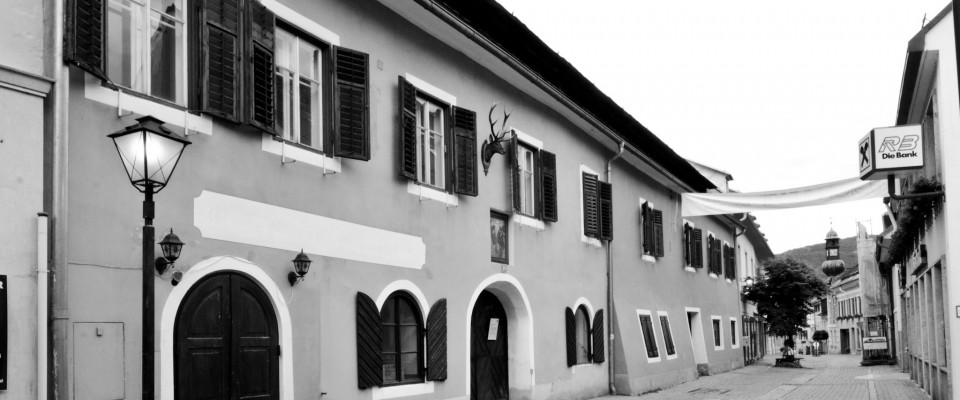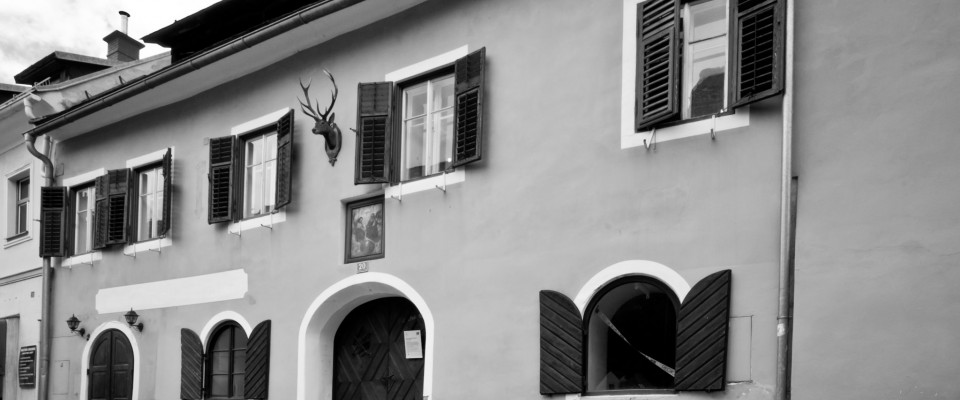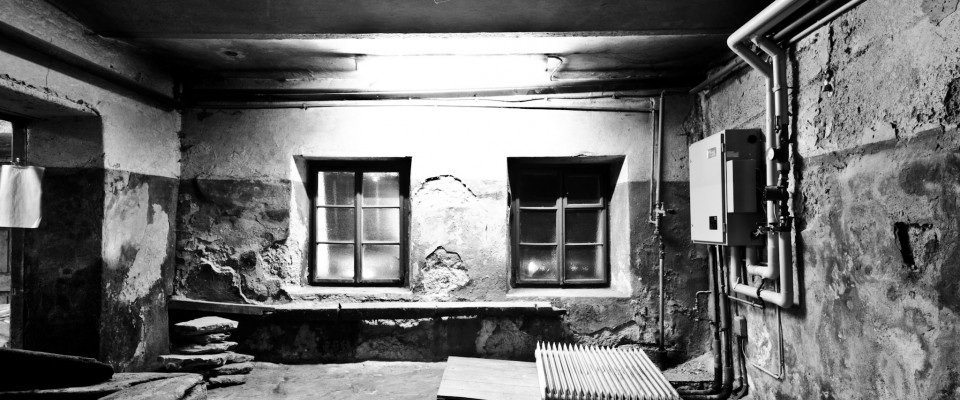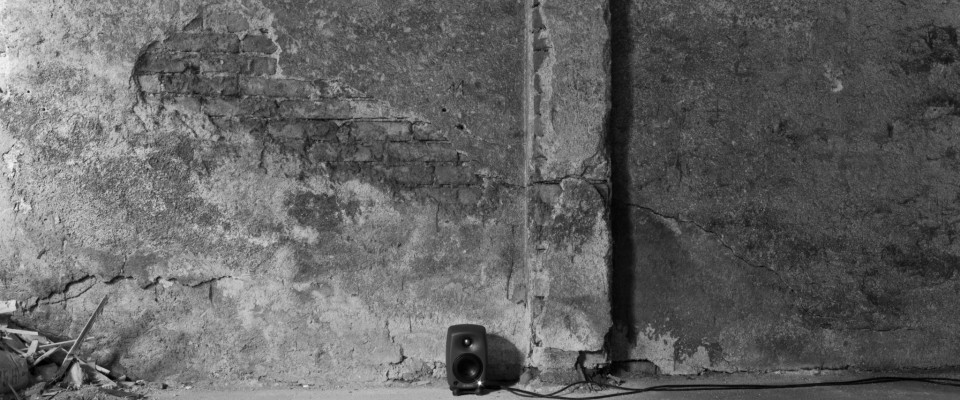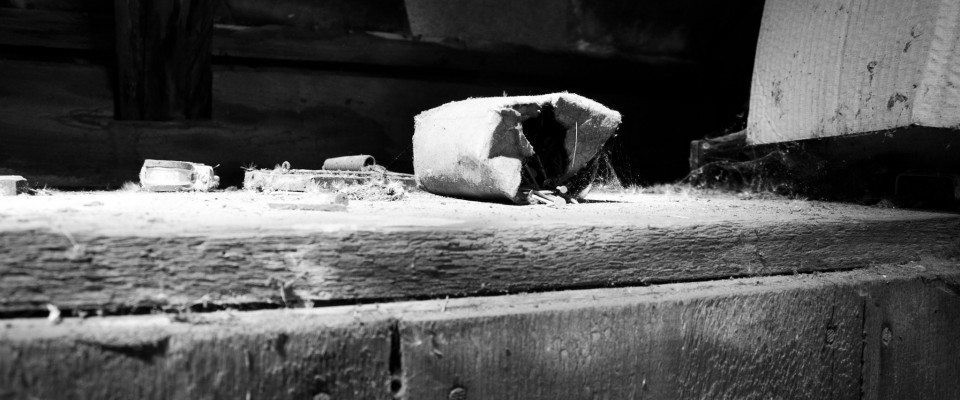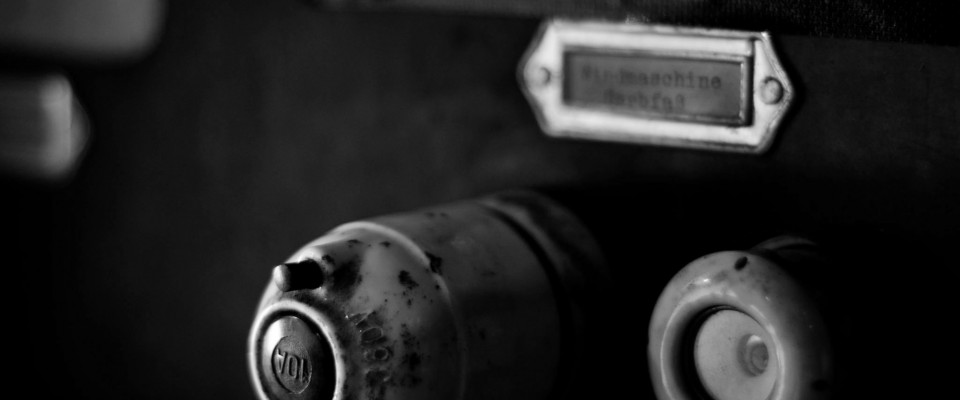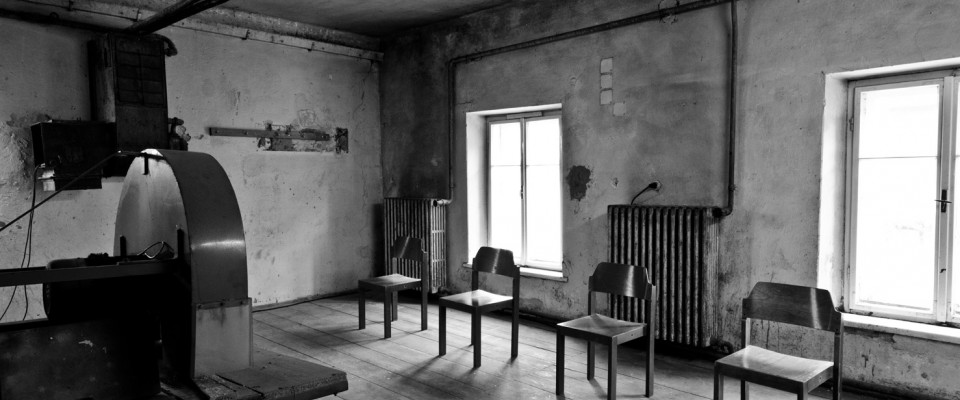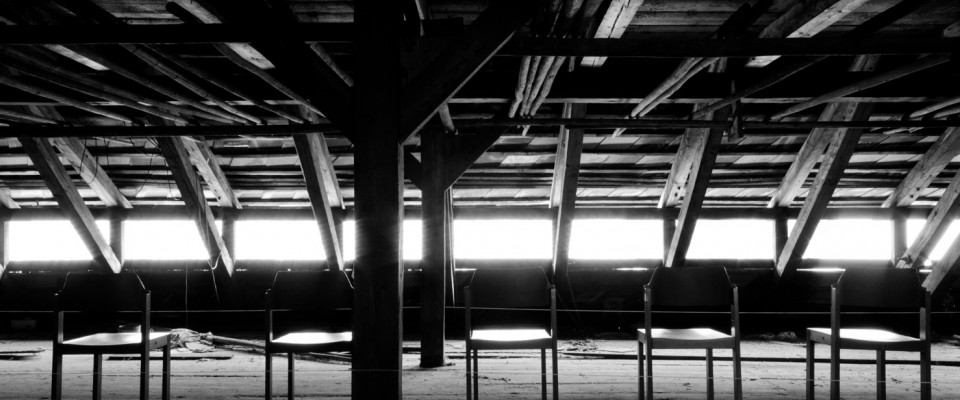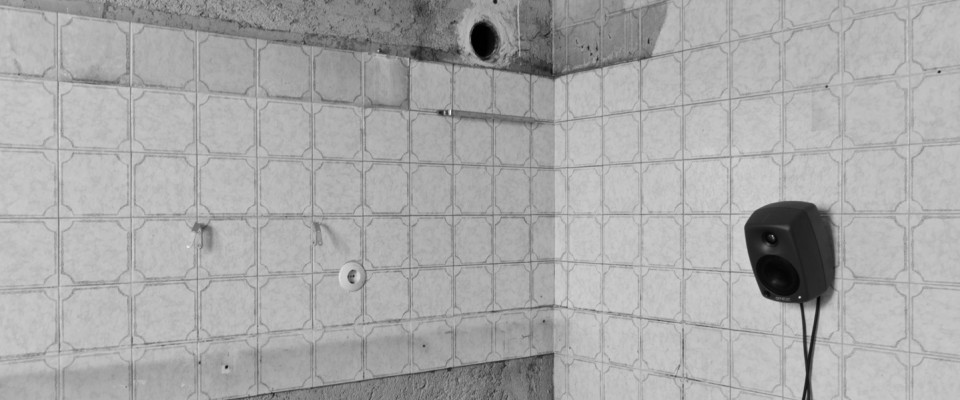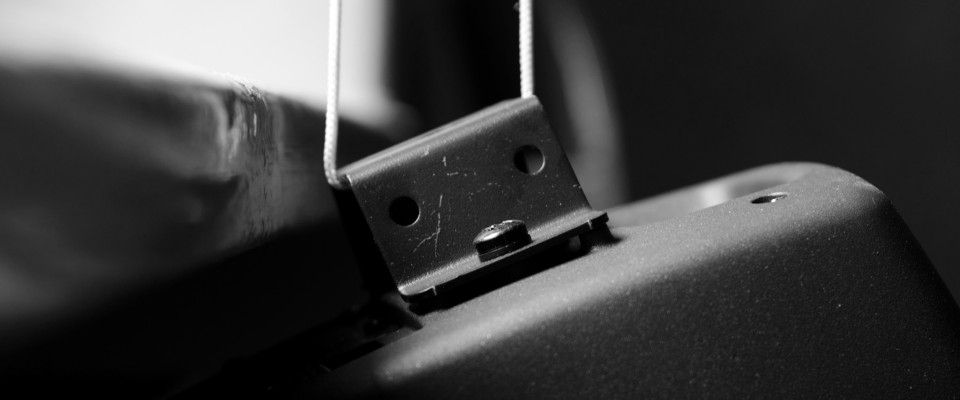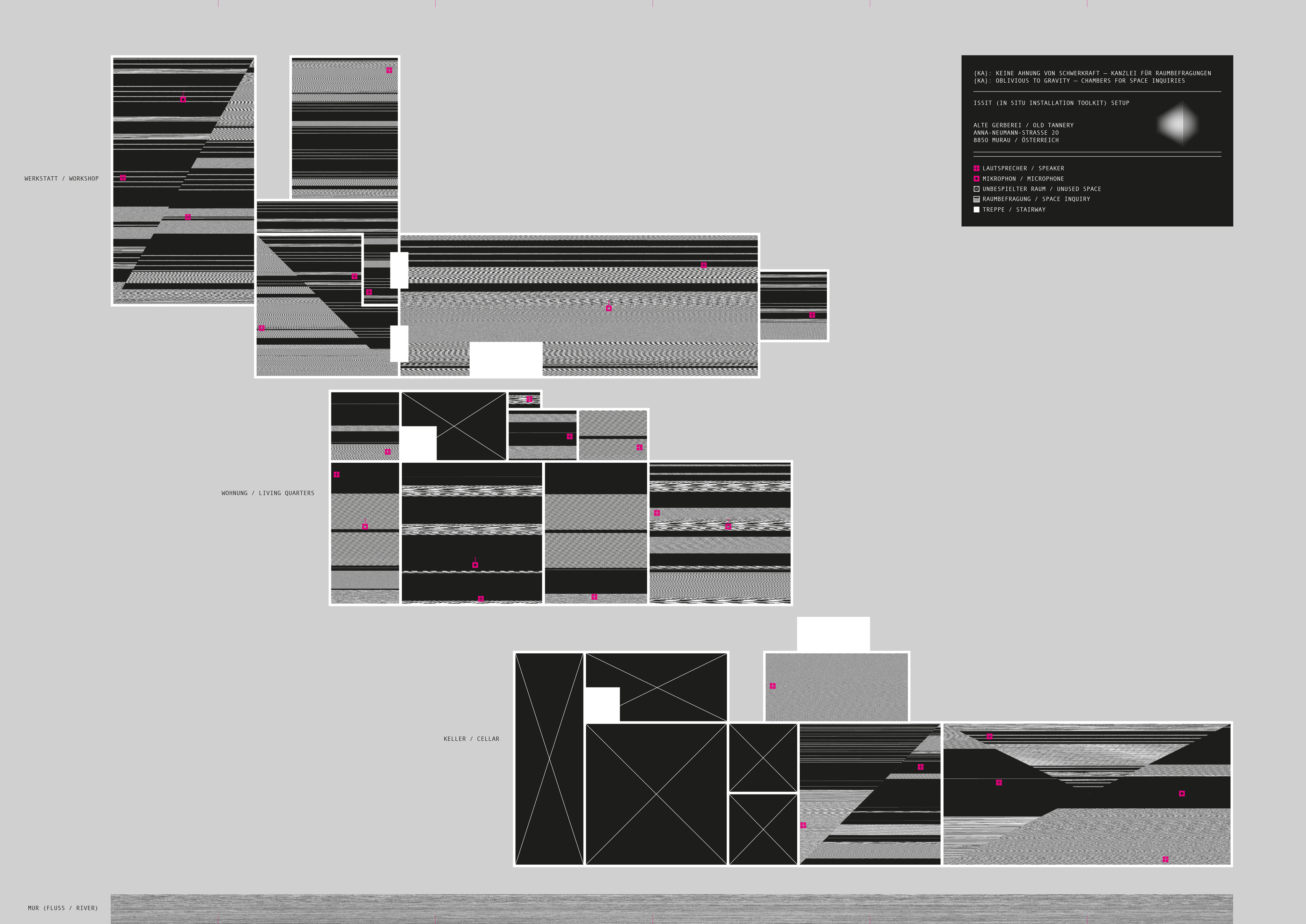{ OPENING }
On June 22nd I present the building to the REGIONALE12 management and so to the public.
During the following month-long festival the building is open every day from 10 am to 8 pm. According to the festival organisers, by the time the installation was dismantled on July 23rd and 24th 2012, the building had been visited by almost 1000 festivalgoers.
{ wiegenlied : MURAU CONCERT }
On 06. and 07.07.2012, a fourth soundscape was opened on the roof of the tannery.
The roof truss is open to the town on all four sides. This is where the wares were previously hung up to dry. Sounds from the town flow through, or at times even flood, this sound zone.
For the special event I installed a second sound installation in this sound environment, the six-channel 'wiegenlied' (lullaby), which I had composed for the German region of North Rhine-Westphalia between 2009 and 2010 for the imposing foyer of the state representative office in Berlin.
At the time I travelled for a year through my home region, gathering sounds from which I then produced sound fragments, rhythmic structures and sounds for the final installation.
Six special concerts were staged with a seated audience of 10 attending each. Six loudspeakers were mounted in the roof truss and played the sound installation 'wiegenlied' mixed live by me, forming an interplay with the surrounding sounds of the town of Murau.
{ APPROACHING UNKNOWN SPACE }
The third building composition in the series {kA}: Oblivious to Gravity investigated the old tannery at Anna-Neumann-Straße 20 in Murau, Austria. This work was part of REGIONALE12, the biennial festival of contemporary art and culture in the summer of 2012.
In the run-up to the festival, the search for a building in the area lasted 13 months. Finally, the choice fell on vacant premises in the town centre, on a well-heeled street with attractive shops, 50% of which now stand empty.
What was previously a stretch of fashionable boutiques now struggles to exist as a narrow through-road for cars. For tourists passing through the district, the windows of the closed shops are decorated with mannequins, signs and displays from the few remaining businesses. For anyone walking briskly past, you could almost overlook the fact that the range of active shops is smaller than the width of the shop window displays would imply.
In order to survive, the vacancy must be disguised with fake consumption.
When I first entered the old tannery in the autumn of 2010, I found myself instinctively holding my breath. Cold, damp, dark and misty – an inhospitable place. The largest building so far in this series of compositions, it stands in the middle of the town centre. An old, solid structure opposite the festival centre of REGIONALE12. Now that the cold is seeping into my bones it becomes clear to me that I have approached the place with a naive idea of old buildings, walls steeped in history, and the detached romanticism of a studio artist. The photos told a different, a different, cosier story: a double-fronted building painted pink and blue, with old wooden shutters and a set of antlers over the doorway, with faded paintings on the facade.
Now – inside – the atmosphere is forbidding, and hostile. Here the stories are enclosed, atmospheres blurred, the first echoes lonely and very brief, the outside world banished, the interior space has lost its original purpose, and the building removed from the active perception of its surroundings. A secret vault. I shine my torch into the corners, looking for junction boxes, finding switches, door handles, passageways, and staircases. Solid stone everywhere, worn grey-brown floors, the walls and the ceilings, solid and hostile. A maze of small rooms, a vaulted cellar, grey. A feeble light filters through the chinks in the thick wooden casings over dull windows. There are old machines, heaps of rubble, stone troughs in the floor, shutters, stone steps that rose from the cellar into a deserted workshop, and a tiled staircase that leads from the entrance into living quarters, with creaking parquet floors. Overtaxed, I shoot off photos, detail upon detail, passages, building materials, bathrooms, abandoned curtains, pictures, lamps, empty spaces, ash from a dismantled tiled stove, an almost endless system of small rooms that has concealed its history and stories. And then on the way back, a hidden door, bolted, behind which I discover a worn, rotten stairway leading upwards. The twittering of birds, the rush of the river Mur, an attic half-open on all sides, the gables presumably stretching across the entire length of the building on solid wooden pillars.
I later learn that it was here that the hides were hung up to dry. My first visit lasts about three hours.
I am to be allowed to use the building freely for three months and during the festival. REGIONALE12 has only stipulated that small groups of visitors should have access to the building. Driving back to Graz, I note down a question: '600m2 of accessible building-sound composition?'
By the time I visit the building a second time on May 26th 2012, months of research and planning with the Chambers for Space Inquiries lie behind me. The town archives have little information to offer on the old tannery. The building is recorded, but only briefly mentioned in the chronicle, the floor plans are incomplete. Nearly everyone knows the old tannery, and has a tale to tell about it; however, conversations are short and hasty. The locals are reluctant to talk about the street, the exodus from the town and its growing vacancy rates. Everyone is affected and we are all intruders here.
On entering the building, a four-week process begins whereby I gradually get to know the building, little by little, day by day. It is hot in Murau, the first tourists flow down Anna-Neumannstraße in T-shirts.
The building, on the other hand, is like a refrigerator. From the first day on, a woolly hat, scarf and fleece are my work uniform. Every day I unlock the door and lock it again behind me. The key hangs next to the door so that I won’t misplace it in the maze. I get changed and then walk through the building, room for room, hour for hour.
{...}
{...}
On the second day the freight forwarder arrives with the equipment from Germany.
An existing system made up of 32 loudspeakers with cables for the whole building, computers, interfaces, all of the instruments needed for building composition that I have planned and tested since 2009 with the Institute for Electronic Music at the University of Music and Performing Arts Graz, and developed further at the sound research studio of the department for musicology at the University of Wuerzburg.
A brief chat with the freight forwarder and his wife, who have accompanied the series since 2010 and then I am once again by myself and alone in the building with its sounds. After a couple of days I get used to the range in temperatures. I chart the spaces and small rooms, as well as the windows and doors facing the street and garden, noting down sound impressions at different times of the day and night. After a week, I know the building and all its spaces and staircases and some of the lighting scenarios well enough to be able to wander through the place mentally.
Following the routines set up for building compositions, from the first day I make audio recordings that I listen to and analyse in the evening at the Hotel Lercher, my home for the following weeks. During breaks I sit by the fountain on the opposite side of the street and try to warm up. At the same time, my recording device is running constantly, capturing the sounds of the street and the 'Murau soundscapes'. The rushing of the River Mur is omnipresent, a wide band that weaves through the overall framework of sound. If one were to eliminate the Mur as a basic sound on the 'soundscape mixing console', the entire urban sound environment within a wide radius would simply implode. The River Mur forms the backbone of the Murau orchestra. It resonates through and in the streets and into the buildings. It is the foundation of all of the aural architectures established by the locals in their life here, day and night.
It soon becomes clear that the building must be divided into sections. Despite the pipework systems and the hatches in the building, there are few acoustic bridges between the different areas and storeys of the building.
A walk-through overall installation, such as was possible in the building composition at Sauraugasse 4 in Graz, cannot be composed from any centralised or decentralised listening environment here. In addition, the various areas of the building possess very different sound qualities due to their original purpose and corresponding structural layouts. The rooms facing the street have a completely different tone to those next to the garden.
Apart from this, because the space must be accessible, various listening points have to be found, another argument for a more localised arrangement and/or conflations of spatial constellations within the framework of the composition. Several weeks of exploration and inquiries have uncovered the atmospheric properties of the spatial complex. For days and nights I experiment in the building with constellations of loudspeakers.
Inquiries with acoustic toolboxes turn out more elaborate than any buildings previously investigated. As an appropriate compositional response a spatial-sound score is developed that anticipates three sound zones, to be composed successively:
1. Cellar
2. Living quarters
3. Workshop
The third audio space is very different from the first two. The higher position of the windows in the building allows more direct sunlight into the spaces. The whole atmosphere seems softer, although no less oppressive. Here one gets the impression that the people who lived here have only just left: wallpaper, linoleum in the kitchen, bathrooms still intact although unused, with mirror lighting. The dents and scratches of vanished furniture mark the floor.
The living quarters are fitted with creaky parquet throughout. Wherever or however one treads here, a variation of sounds is produced in all the spaces. Closing my eyes, I imagine that four people are here, moving around in the various rooms.
I hear a concert.
This becomes the first rule of composition of sound and dynamic development in this area: that all of the added elements, as well as the loudspeaker positions, are oriented according to the resonance and percussivity and/or the respective potential of the parquet flooring. This means first of all that the composed interventions must be light and fragile in their basic tone. Further to this, because of the potential for stimulation in the parquet, there must be far more space (gaps) than was the case in the two previous sections of the building.
On entering the storey, it could be that one hears nothing at all at first because one is expecting to encounter a different intensity of sound. It is only after one has attuned one’s ears to a 'lower' range that one notices the overall composition. In parts, the sounds are so 'subliminal' in their loudness and movement that while composing and listening back to them I have to hold my breath in order not to eliminate my audio impression with the sound of my breathing. Every single sound event belongs to the composition. Right up until the end of the exhibition, a large fly was caught in the living quarters and occasionally buzzed around. Afterwards, visitors commented time and again on the loud volume of its flight.
In order to incorporate the garden area and to integrate the outside world in situ into the spatial composition, a window in the kitchen is left tilted open. One hears the birds and twice a day the barking of the dog, as well as the stream that runs under the house and into the River Mur. Here too, nine 8-channel spatial sound compositions each 3'30'' long are created, and divided into three atmosphere and movement groups. These are selected and played by a computer.
The narrow stone stairs at the back of the vaulted cellar take one up into the workshop. A winding corridor connects a system of four workrooms and a small lavatory, whose ventilation hatch forms the only acoustic bridge to the living quarters in the second section of the building.
The atmosphere here is much more welcoming than that of the vaulted area. Daylight streams through large windows from the garden side. Here, likewise, a system of loudspeakers based on previous building inquiries and personal appropriation of acoustic conditions is installed in the rooms, machines, corners and pipes.
A window in the upper workshop area facing the garden side is fixed open. Twice a day the barks of a dog (to this day I do not know what it looked like) can be heard from inside. The birds in the garden extended the musical audio space across the walls at the back of the building. The disused machines stand in the space like silent sculptures. Once upon a time, they must have made a deafening row.
The first compositional response is given in the cellar area.
The barred windows on the street side form a membrane between the building’s interior and the outside world. The noise of cars and pedestrians clearly penetrates the slightly vibrating window panes, then vanishes for a moment, since they are screened by the thick walls, returning again more clearly at the next window. Although hidden from view, the street is the element within the cellar atmosphere that defines the entire situation.
The windows and walls act as a filter on the sound sources that pass by at different speeds. The stone troughs, spaces and little rooms towards the middle of the building act primarily as resonance spaces. Apart from a very quiet rush of water, there are no characteristic noises to be heard there. In the spatial-sound zone the first loudspeaker system is installed mainly in order to activate the resonance spaces and to amplify the street movements. Over the days that follow, I sit here and try to make what I have learned from the previous acoustic inquiries flow into an investigation of the space and my impressions and recordings.
For this I put to use the techniques for spatial composition developed in recent years in buildings - for sound recording, amplification, synthesizing and filtering and of course spatialisation.
Six 3'30'' long space sound miniatures are produced, divided into three atmosphere groups. Having switched itself on in the morning, the computer chooses the first miniature at random and then follows a programmed set of rules with regard to the selection of the following composition, sequence and repetitions. Each selection process lasts 10 seconds.
Nine spatial sound compositions, divided into three groups, are created here, each likewise 3'30'' long. They too are chosen and played at random by a computer as described above. If one remains in this space-sound zone for about 33 minutes, each of the nine compositions will have been played.
Building-sound compositions are not a matter of recreating the original sounds that enter one's consciousness in situ. The site and its sound properties should not be reproduced. Neither are concrete sounds played here in order to evoke events visually from a fictitious past (disused drive motor – machines working, tiled empty kitchen – cooking noises), to construct or even reconstruct them. Oblivious to Gravity rejects the historicising audioplay.
The here and now is what is important.
The former residents are no longer here, some are no longer alive, the machines are not in use or have been dismantled. The door handles are no longer used and there is no water in the bathrooms. Film sound design is also quite the opposite of Oblivious to Gravity. In film, or rather in the cinema, the visitor’s body is switched off, comfortably cushioned, sedated or even dissipated. Space is sealed off, so that it has as little character of its own as possible. One's attention is fixed on a minimal field. Technical equipment disappears, cables are buried and hidden.
On the screen, almost every door handle and every space gets a designed mantle of sound, has the sound of another door handle and a recorded place imposed over it, so that we believe that we are hearing exactly what we see – a duplication, a confining of perception to a mostly linear and one-dimensional narrative style. What would happen if the door handle did not make a noise when it was turned, and/or the railway station concourse sounded muffled, like a sitting room? As a visitor, one would pause in the narrated time, ask one’s self questions and immediately make an associative search for a solution to the tension, a bridge between the 'mismatched' elements. One would need to develop a proper time in order to be able to formulate the story one's self.
Oblivious to Gravity searches for sounds that are far enough removed from machines, sound–space situations, outside sounds and material noises that they do not become a 'sound track', yet at the same time are sufficiently associative with the overall acoustic pattern and a range of individual events from the surroundings that perception is pointed towards these individual events and prompted to link these actively and independently with the artificial soundscape or even to hear the two worlds as one.
It is therefore a question of opening up the building for the visitor in order to challenge their perception, so that they get to know the building, to reveal the building, and to explore the building as a space of possibilities, to enter into an Listening-dialogue with it. A continuous staged interplay between strangeness and occupance of the conditions.
{ PERFORMANCE OF INTRINSIC SOUND AND ENVIRONMENT }
Visitors can move freely throughout the building or sit for a while on the seating provided by me. The chairs were arranged according to acoustic criteria; between two and five chairs were placed in a spatial situation depending on the acoustic axis and relevant resonance areas.
In this way the composed interplay between the building, the sounds in the building’s surroundings and electroacoustic soundscape as well as the installation can be passed, or heard while sitting as if at a concert. In this case, the visitor becomes part of the staging.
Among other things, movements produce noises on the various floors (parquet, stone, clay) that are integrated into the atmosphere of each spatial zone or which are in turn placed in relation to the visitor’s surrounding soundscape and/or combined into a single atmosphere by other visitors in their perception, walking or sitting, visually and acoustically.
At the same time, the state of active listening required by the work demands that the visitors display an attitude of awareness towards one another. If one does not notice one’s own acoustics, one can drastically disrupt others’ soundscapes or, on the other hand, experience them as a quiet observer.
An everyday phenomenon forms an important focus of this series of works.
Building vacancy has always existed; however, in the last 15 years it has become increasingly noticeable in city centres and on the peripheries. Above the ground-level shops, some pedestrian zones are virtually deserted. Where previously discreet estate agents’ signs advertised properties as available for rent, in more recent years the banners on the facades proclaiming 'To let, no commission!' have grown larger and larger, while at the same time, a few metres further on, an office or commercial construction boom is occurring.
Within the context of the work, there is a temporary rededication of a building seen as 'empty', useless in a commercial sense, over the years usually hermetically sealed off from its environment, waiting to be demolished or gutted, yet at the same time holding on to its own history, configuration and atmosphere. The intention is to use formerly commercial and social buildings fully integrated within the urban environment (offices, hospitals, department stores, hotels, local government buildings) as a setting for sound art, which due to their past are steeped in forms, architectural aesthetics, sound properties (echoes, absorption properties of spaces, etc.) and not least stories.
There are vacancies like these in every city and town. Places that either stand empty for a long time or are waiting to be gutted and rededicated or to be demolished, until they find a new investor who will carry out the restructuring. This 'encapsulation' in public space can sometimes take years, so that after a short while passers-by no longer notice these buildings; they vanish from public perception.
Within the totality of conscious urban space, a void develops: a non-place. Only when the scaffolding goes up or the demolition equipment is moved in does the place return to 'the public'. Gaps in perception are starting-points in the arts: here is where new territories can be entered and explored, where fundamental questions (such as the individual and their sound environment, (un)conscious acoustic soundscape) can be combined in a new way and addressed as a theme. Beyond this, however, the medium of sound art should be used to produce an ephemeral work that takes as its basis precisely this 'rejected' building, created from the building and the place. This means the history, architectural features, range of materials and profile (open-plan offices since the 1980s, small bedrooms in the trade fair hotel, stone/marble flooring in the entrance halls of international office buildings, etc.) become elements within an overall art concept.
What can often be a biased, disparaging way of seeing and hearing these vacancies or even non-places in our direct vicinity should be broadened with alternative interpretation.
These non-places are also opportunities.



